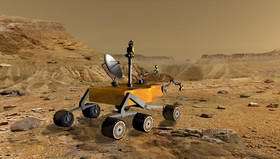NASA picks two IU devices to go to Mars

Two of the eight instruments selected to go on a Mars rover have Indiana University Bloomington geologists behind them, NASA announced yesterday.
One of the devices will provide scientists with a closer look at Mars -- literally. The other will tell us, for the first time, what Mars is actually made of.
Photo: This artist's conception shows the NASA Mars Science Laboratory rover exploring a canyon plateau. (NASA/JPL)
The rover mission is named Mars Science Laboratory and currently is slated for Earth launch in 2009, Mars arrival in 2010. The mission is part of NASA's Mars Exploration Program, which will "deliver a mobile laboratory to the surface of Mars to explore a local region as a potential habitat for past or present life," according to NASA's press release.
Despite decades of study, scientists still don't know what rocks make up Mars' surface, let alone the strata underneath. Scientists know roughly what elements exist on Mars but not how they're organized in minerals and rocks. To begin addressing that deficiency, IUB geologist David Bish is working with colleagues from Los Alamos National Laboratory, NASA's Ames Research Center and NASA's Jet Propulsion Laboratory to develop a miniature "x-ray diffractometer" that can parse the Martian surface. Typical x-ray diffractometers are the size of large refrigerators -- way too big for NASA's diminutive rovers. So far, the team has gotten the device down to toaster-size, which is, remarkably, still too big.
"We've got to get the diffractometer down to the size of a Coke can," said Bish, a recent Los Alamos emigre who holds the Haydn Murray Chair in applied clay mineralogy. "I think we can do it in time to get the device on a 2009 mission."
IUB sedimentologist Juergen Schieber's contribution to Mars Science Lab will be a wide-angle microscopic camera for imaging rocks, soil, frost and ice at resolutions never before achieved. Schieber will be working with Ken Edgett of Malin Space Science Systems on the project.
Source: Indiana University


















